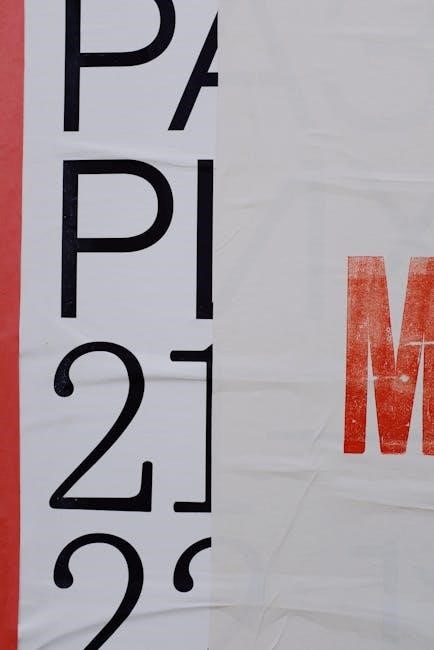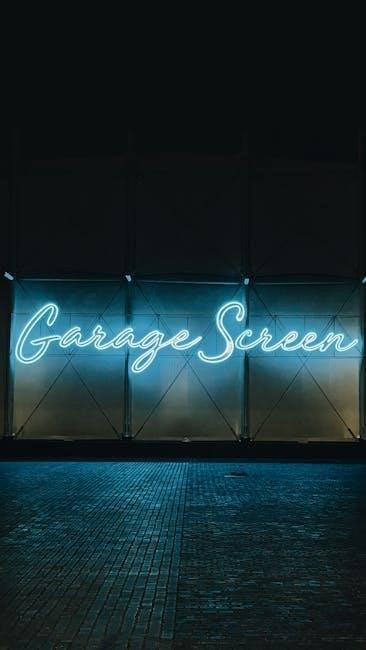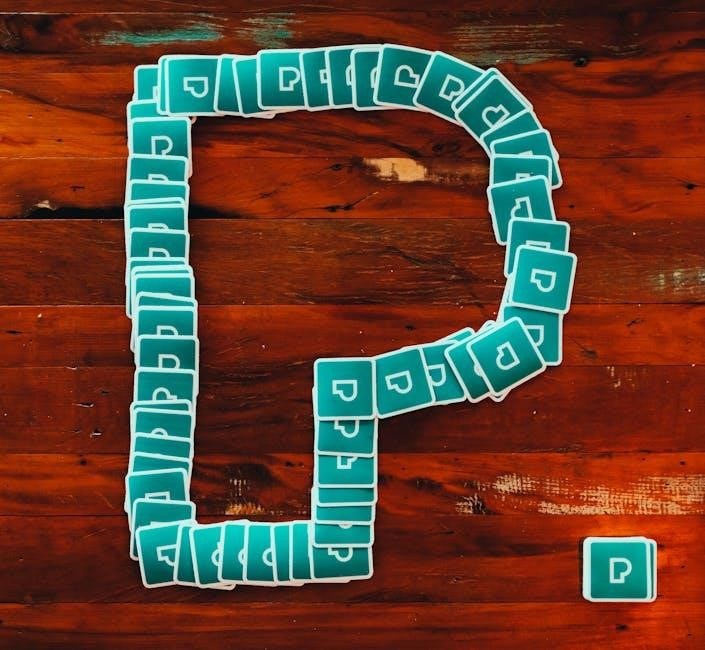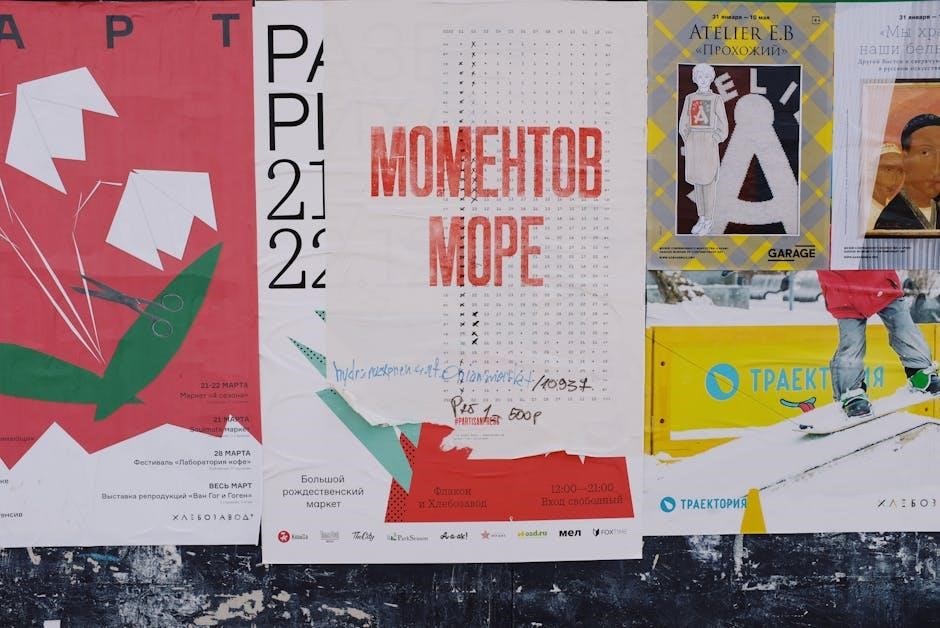
text structure graphic organizers pdf
Text structure graphic organizers are versatile tools designed to help students identify and understand the organizational patterns in written content, enhancing comprehension and critical thinking skills effectively.
Definition and Purpose
Text structure graphic organizers are visual tools designed to help students identify and analyze the organizational patterns within written texts. These organizers provide a framework for breaking down information, making it easier to understand and retain. Their primary purpose is to enhance comprehension by visually mapping out text structures such as cause-and-effect, comparison, or sequence. They also serve as a guide for pre-reading, during reading, and post-reading activities, helping students engage deeply with the material and develop critical thinking skills.
Importance in Education
Text structure graphic organizers play a crucial role in education by helping students identify and analyze the underlying patterns in texts. They enhance comprehension by visually mapping out information, making complex concepts more accessible. These tools foster critical thinking and improve retention, enabling students to engage deeply with material. By supporting diverse learning styles, graphic organizers ensure inclusivity and cater to varied educational needs, making them an indispensable resource for effective teaching and learning across all grade levels.

Types of Text Structures
Common text structures include cause and effect, comparison and contrast, problem and solution, description, and sequence or chronological order. These patterns help organize information coherently.
Cause and Effect
Cause and effect is a text structure that explains how events are related, with one action leading to a consequence. Graphic organizers for this structure often use flowcharts or timelines to visually map causes and their resulting effects. These tools help students identify and analyze relationships between events, enhancing their ability to understand causal links in texts. By breaking down information into clear, connected components, cause and effect graphic organizers promote critical thinking and structured analysis, making complex relationships easier to comprehend and discuss.
Comparison and Contrast
Comparison and contrast text structures highlight similarities and differences between topics. Graphic organizers for this structure often use Venn diagrams or T-charts, allowing students to visually list and compare attributes. These tools enable learners to systematically analyze relationships, making it easier to identify commonalities and distinctions. By organizing information in a structured and visual format, comparison and contrast graphic organizers enhance understanding and support clear, focused analyses of complex topics.
Problem and Solution
Problem and solution text structures present an issue and the steps taken to resolve it. Graphic organizers for this structure often use flowcharts or tables to map out problems, solutions, and their outcomes. These tools help students identify cause-and-effect relationships and evaluate the effectiveness of solutions. By visually organizing the problem and its resolution, learners can better understand the logic and sequence of events, enhancing their ability to analyze and communicate solutions clearly and effectively in their own writing.
Description
Description text structures provide detailed explanations of people, places, objects, or events. Graphic organizers for description often use charts, maps, or diagrams to help students visually organize sensory details and main ideas. These tools enable learners to break down complex descriptions into manageable parts, such as physical characteristics, settings, or key features. By structuring information visually, graphic organizers enhance understanding and retention, making it easier for students to identify and communicate the essential elements of a description in their reading or writing tasks.
Sequence or Chronological Order
Sequence or chronological order text structures organize events or ideas in a time-based or step-by-step manner. Graphic organizers for this structure often use timelines, flowcharts, or sequential maps to help students visually arrange information. These tools enable learners to identify the order of events, cause-and-effect relationships, and transitions within a text. By breaking down complex sequences into clear, visual steps, graphic organizers enhance comprehension and retention, making it easier for students to follow and analyze the progression of ideas in their reading or writing tasks.

Role of Graphic Organizers in Text Structure
Graphic organizers play a crucial role in visually representing text structures, enhancing comprehension, and fostering critical thinking through structured, engaging layouts.
Visual Representation of Information
Graphic organizers provide a clear visual framework for understanding text structures, breaking down complex information into manageable, interconnected components. By using shapes, colors, and spatial arrangements, they transform abstract concepts into tangible, easy-to-follow diagrams. This visual approach helps students identify relationships between ideas, such as cause and effect or comparison and contrast, making comprehension more intuitive. Visual representations also support diverse learning styles, particularly benefiting visual learners who thrive on structured, image-based learning tools. This method enhances retention and engagement, making complex texts more accessible and understandable for students of all ages.
Enhanced Comprehension and Retention
Graphic organizers significantly enhance comprehension by presenting information in a structured, visually appealing format. By breaking down complex texts into clear, organized sections, students can better grasp relationships between ideas. This visual structure aids in identifying key details, main ideas, and textual patterns, making retention more effective. The use of graphic organizers also helps students review and revisit material, reinforcing their understanding and memory of the content. This tool is particularly effective for visual learners, ensuring that information is both accessible and memorable.
Improved Critical Thinking and Analysis
Graphic organizers foster critical thinking by enabling students to analyze and evaluate information systematically. They help identify relationships between ideas, evaluate evidence, and synthesize information. By visually mapping out text structures, students develop the ability to question, interpret, and draw meaningful conclusions. This structured approach encourages deeper engagement with the material, promoting analytical skills and the ability to think logically. The clear visual framework also supports students in organizing their thoughts, making it easier to identify patterns and connections within the text.

Benefits of Using Graphic Organizers
Graphic organizers enhance learning by improving organization, engagement, and comprehension. They provide clear structures, simplify complex information, and cater to diverse learning styles, fostering better academic outcomes.
Organization and Structure
Graphic organizers provide a structured framework for organizing information, enabling students to break down complex content into manageable sections. By categorizing details into clear formats, such as cause-and-effect or problem-solution layouts, students can better grasp relationships between ideas. These tools also help teachers present information coherently, ensuring lessons are logically arranged; The use of PDF templates and digital versions offers standardized formats, promoting consistency and clarity in both teaching and learning environments, making it easier for students to follow and retain information effectively.
Simplified Learning Process
Graphic organizers simplify learning by presenting information in a clear, visual format, making complex concepts easier to understand. They help students grasp text structures like cause-and-effect or comparison-contrast by breaking content into digestible parts. These tools also aid in retaining information by providing a structured framework for notes and ideas. Printable PDF versions ensure accessibility, allowing teachers to distribute them effortlessly. By visually organizing knowledge, graphic organizers streamline the learning process, helping students focus on comprehension rather than information overload. This approach supports diverse learning styles, making education more inclusive and effective.
Support for Diverse Learning Styles
Graphic organizers cater to diverse learning styles by providing visual, structured frameworks that accommodate different preferences. Visual learners benefit from diagrams and charts, while kinesthetic learners can engage with hands-on activities using printable PDF templates. Auditory learners can pair discussions with organizer completion. These tools also support English language learners and students with special needs by simplifying complex texts. The adaptability of graphic organizers ensures all students can access and process information effectively, fostering an inclusive learning environment that addresses individual needs and preferences. This flexibility enhances overall engagement and understanding.

How to Create Text Structure Graphic Organizers
Design graphic organizers with clarity, incorporating visual elements and customization options for specific text structures like cause-effect or comparison, ensuring they are user-friendly and adaptable for various learning needs.
Designing for Clarity
Creating clear graphic organizers involves using simple, intuitive layouts that visually represent text structures like cause-effect or comparison. Incorporate clean lines, distinct sections, and minimal clutter to ensure ease of use. Use PDF templates for consistent printing quality and consider digital tools like Google Slides for editable versions. Ensure labels and instructions are legible, with ample space for student input. Customizable designs allow teachers to tailor organizers to specific lessons, making them more effective for diverse learning needs and enhancing student engagement with the material.
Incorporating Visual Elements
Incorporating visual elements enhances the effectiveness of graphic organizers by making complex text structures more accessible. Use images, colors, and diagrams to highlight relationships between ideas. Tools like Venn diagrams for comparisons or mind maps for brainstorming simplify understanding. Visual cues such as arrows or icons can guide students through sequences or cause-effect relationships. High-resolution PDF templates ensure clarity, while digital tools like Google Slides allow customization with images and shapes. Visual elements engage diverse learners, making abstract concepts concrete and fostering deeper comprehension and retention of the material.
Customizing for Specific Text Structures
Customizing graphic organizers for specific text structures ensures they align with the content’s needs. For example, a Venn diagram is ideal for comparison and contrast, while a timeline suits chronological order. Cause-and-effect relationships can be visually mapped with flowcharts or T-charts. Problem and solution structures benefit from boxed sections for clear separation. Description-based organizers may include image frames for visual references. PDF templates offer pre-designed layouts, while digital tools like Google Slides allow educators to tailor organizers further, ensuring they meet the unique demands of each text structure effectively.

Popular Formats of Text Structure Graphic Organizers
Popular formats include PDF templates for easy printing, editable digital versions for customization, and interactive online tools for dynamic engagement, catering to diverse teaching and learning needs effectively.
PDF Templates for Easy Printing
PDF templates are widely available and provide a convenient way to access graphic organizers for text structures. These templates are designed for easy printing, making them ideal for classroom use. They often include layouts for popular text structures like cause and effect, comparison and contrast, and problem and solution. Many PDFs are customizable, allowing teachers to tailor them to specific lessons or student needs. Their clear and visually structured format makes them accessible for students of all grade levels, ensuring effective organization and comprehension of information. Additionally, fillable PDFs enable digital completion without printing, offering flexibility for modern classrooms.
Editable Digital Versions
Editable digital versions of graphic organizers offer flexibility and customization, allowing teachers to tailor templates to specific lessons or student needs. Platforms like Google Slides and Edrawsoft enable easy modifications, such as adding questions, images, or additional sections. These versions are ideal for interactive classroom activities or homework assignments, promoting engagement and collaboration. Digital tools also save time, as they eliminate the need for printing and can be shared instantly. Teachers can adapt these organizers to suit diverse learning styles, ensuring all students benefit from structured and visually appealing learning resources.
Interactive Online Tools
Interactive online tools, such as Easel by TpT and Edrawsoft, provide dynamic ways to create and customize graphic organizers. These tools often feature drag-and-drop functionality, real-time collaboration, and the ability to embed multimedia. They allow students to engage actively with content, fostering deeper understanding and creativity. Many platforms offer fillable fields, making it easy for students to input information digitally. These tools are particularly useful for remote learning and differentiated instruction, enabling educators to adapt activities to meet diverse student needs while promoting interactive and self-paced learning experiences. They also save time and enhance overall learning efficiency.
Classroom Applications of Text Structure Graphic Organizers
Teachers use graphic organizers to enhance comprehension, structure pre-reading activities, and support during and post-reading strategies, helping students visually organize and analyze information effectively.

Pre-Reading Activities
Graphic organizers are valuable in pre-reading activities to set purposes and activate background knowledge. Teachers use them to introduce text structures, helping students anticipate content and identify key themes. By visually mapping relationships and concepts, organizers enhance engagement and focus. They also encourage students to formulate questions and predictions, fostering critical thinking. These tools bridge prior knowledge with new information, creating a structured approach to comprehension. Pre-reading graphic organizers ensure students enter reading with clear goals and a framework for understanding complex texts effectively.
During Reading Strategies
During reading, graphic organizers help students actively engage with the text by visually mapping its structure and content. They can identify and track events, causes and effects, or comparisons as they read. Organizers like Venn diagrams, timelines, or concept maps allow students to break down complex texts into manageable parts. By filling out charts or diagrams, students connect new information to prior knowledge, enhancing comprehension. These tools also enable real-time analysis, helping students monitor their understanding and make meaningful connections between ideas and text structures effectively.
Post-Reading Reflections
Post-reading reflections with graphic organizers help students consolidate their understanding of the text. They can summarize key points, analyze the author’s intent, and reflect on how the text structure contributed to the message. Organizers provide a space to connect ideas, identify patterns, and evaluate the effectiveness of the text’s structure. This reflective process enhances retention, critical thinking, and the ability to articulate insights clearly. By revisiting the text through organizers, students deepen their comprehension and develop a stronger grasp of how authors communicate their ideas effectively.

Digital Tools for Graphic Organizer Creation
Digital tools like Canva, Lucidchart, and Edrawsoft offer customizable templates and drag-and-drop features, enabling educators to create and share graphic organizers efficiently for various text structures and educational needs.
Google Slides and Easel by TpT
Google Slides and Easel by TpT are popular digital tools for creating graphic organizers. Google Slides offers customizable templates and real-time collaboration, making it ideal for group projects. Easel by TpT provides interactive, ready-to-use templates that cater to diverse learning needs. Both platforms allow educators to design visually appealing organizers, incorporate multimedia elements, and share resources easily with students. These tools enhance engagement and simplify the process of teaching text structures, making them invaluable for modern classrooms aiming to integrate technology seamlessly into instruction.
Edrawsoft and Other Graphic Organizer Software
Edrawsoft and other graphic organizer software offer powerful tools for creating customized visual aids. These programs provide pre-designed templates and drag-and-drop features, making it easy to craft organizers tailored to specific text structures. They support collaboration, allowing multiple users to work on projects simultaneously. Additionally, many software options include advanced features like shape libraries and color schemes, enhancing the visual appeal of organizers. These tools are particularly useful for educators and students needing professional-grade resources to support learning and teaching text structures effectively in a digital environment.
Online Templates and Resources
Online platforms offer a wide variety of free and customizable graphic organizer templates in PDF and digital formats. Websites like Edrawsoft and educational blogs provide pre-designed templates for text structures such as cause-and-effect, comparison, and sequence. These resources are easily downloadable and adaptable to meet specific teaching needs. They often include interactive features, allowing students to fill them out digitally. Educators can access these tools to create visually appealing and structured learning materials, enhancing student engagement and understanding of complex text structures.

Assessment and Feedback Using Graphic Organizers
Graphic organizers enable educators to assess student understanding visually, track progress, and provide constructive feedback. They simplify evaluation of text structure comprehension and support individualized learning needs effectively.
Evaluating Student Understanding
Graphic organizers provide a clear visual framework for assessing how well students grasp text structures. By examining completed organizers, teachers can identify gaps in comprehension and track progress over time. These tools reveal students’ ability to identify cause-and-effect relationships, compare-and-contrast concepts, and sequence events logically. The structured format makes it easier to evaluate critical thinking and analysis skills, ensuring learners understand and apply text structure effectively. This visual approach simplifies complex information, helping educators pinpoint areas needing additional support and tailor instruction to meet diverse learning needs.
Providing Constructive Feedback
Graphic organizers enable teachers to provide clear, specific feedback on students’ understanding of text structures. By reviewing completed organizers, educators can pinpoint strengths and areas for improvement, offering targeted guidance. For example, if a student struggles with cause-and-effect relationships, the organizer reveals gaps in their analysis. Teachers can then provide actionable suggestions, such as “Look for transition words like ‘because’ to identify causal links.” This structured approach ensures feedback is timely, relevant, and tailored to individual needs, helping students refine their skills and deepen comprehension effectively.
Tracking Progress Over Time
Graphic organizers allow educators to monitor students’ understanding of text structures over time, identifying growth and areas needing review. By regularly using these tools, teachers can track improvements in how students identify and analyze patterns like cause-and-effect or comparison-contrast. Progress can be documented through dated PDF versions or digital updates, providing a clear record of development. This longitudinal approach helps tailor instruction, ensuring students build on prior knowledge and gradually master complex text structures, fostering continuous improvement in reading comprehension and critical thinking skills. Consistent use enhances learning outcomes effectively.

Free Resources for Text Structure Graphic Organizers
Free PDF templates, editable digital versions, and interactive tools are widely available online, offering versatile options for teachers to download and customize for classroom use effectively.
Printable PDFs and Worksheets
Printable PDFs and worksheets are excellent resources for teaching text structures, offering pre-designed templates for cause-and-effect, comparison, and problem-solution scenarios. These materials are readily available online, often free of charge, and cater to various grade levels. Teachers can easily download and print them, ensuring students have structured tools to organize their thoughts. Many PDFs are customizable, allowing educators to adapt them to specific lessons or student needs. These resources are ideal for classroom use, providing visual aids that enhance learning and comprehension of complex text structures effectively.
Open-Source Templates
Open-source templates for text structure graphic organizers are freely available online, offering customizable designs for educators and students. These templates support various text structures, such as cause-and-effect and comparison, and can be edited to suit specific learning needs. Platforms like Google Slides and Edrawsoft provide editable versions, enabling users to tailor organizers for different subjects or grade levels. These resources are particularly useful for creating interactive and visually engaging tools, making them ideal for diverse classroom applications and enhancing the learning experience effectively.
Education Websites and Blogs
Educational websites and blogs provide a wealth of free resources for text structure graphic organizers in PDF format. Platforms like HMH, Literacy Leader, and Champion Learning offer customizable templates for various text structures, such as cause-and-effect and comparison. These resources are designed to support teachers in creating engaging and structured learning materials. Many websites also feature blogs with tips on implementing graphic organizers effectively, making them invaluable for educators seeking to enhance student understanding and critical thinking skills in the classroom setting.
Text structure graphic organizers are powerful tools that enhance learning by providing clear frameworks for understanding and analyzing content, empowering students and educators alike for educational success.
Text structure graphic organizers are essential tools for enhancing reading comprehension and writing skills. They help students identify patterns like cause-effect, comparison, and sequence. These visual aids organize information, making complex texts manageable. They support diverse learning styles and improve critical thinking. Educators can use PDF templates or digital tools for flexibility. By integrating graphic organizers, teachers foster deeper understanding and retention of material, benefiting students across various subjects and skill levels. Their versatility makes them invaluable for modern educational strategies.
Final Thoughts on Implementation
Implementing text structure graphic organizers effectively enhances teaching and learning experiences. Educators can utilize PDF templates or digital tools like Google Slides for flexibility. These organizers foster engagement, critical thinking, and improved comprehension. By integrating them into lesson plans, teachers can cater to diverse learning styles and adapt to student needs. Regular use promotes better retention and analytical skills, making them a valuable resource for educators seeking innovative ways to support student success in understanding complex texts.

Leave a Reply
You must be logged in to post a comment.